Prior to take-off, the crews of a Boeing 767 (767) and a Boeing 737 (737) received clearances to depart Sydney via a runway 34 right MARUB 3 standard instrument departure on climb to 5,000 ft initially. They were subsequently cleared to climb to flight level (FL) 280. That procedure required the aircraft to turn right after take-off and to track to MARUB, located 15 NM east of the airport. The aircraft were then required to turn right and track southeasterly until leaving 10,000 ft, before turning further right to track to Wollongong and then to continue their planned route to Melbourne. As the aircraft taxied for departure, the air traffic controller advised the crews of an approaching line of thunderstorms that could affect their aircraft en route, to the southwest of the airport.
The 767 departed at 1314 Eastern Summer Time and the 737 departed at 1324. Both crews subsequently diverted their respective aircraft east of the cleared track due to thunderstorms on the planned track and entered restricted area 495 (R495) at 1330 and 1338 respectively. The area was active with Royal Australian Air Force (RAAF) F/A-18 Hornets and a Learjet operating with Royal Australian Navy (RAN) ships. The 767 and the 737 entered R495 without a clearance and were in the same part of the area as a number of Hornets. The investigation did not establish the actual proximity of aircraft and if any information regarding the 767 and 737 was issued to the crews of the military aircraft.
A Bureau of Meteorology (BoM) assessment of the meteorological situation reported that the weather across New South Wales (NSW) was dominated by a low-pressure centre located on the south coast of NSW. A trough extended from the low through to the southwest of inland Queensland, and the middle and upper atmospheres were dominated by strong westerly to north-westerly winds. During the day, the low and the trough moved slowly northeast. The atmosphere on and east of the trough was very unstable and by 1200 thunderstorms and heavy showers began to form near the trough. Due to the atmospheric conditions those thunderstorms quickly formed into squall lines and they moved towards the coast at speeds of about 40 knots.
At about 1200, the Sydney meteorological radar showed that a line of showers had moved eastward and was just to the west of a line from Bathurst to Goulburn. The 1230 radar scan identified the presence of thunderstorms in that line of showers, which was about 50 NM from Sydney airport (Figure 1), and moving in an easterly direction (Figure 2 to 4).

Figure 1: Sydney Radar 1233 |
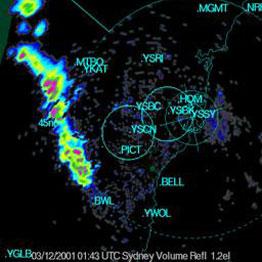
Figure 2: Sydney Radar 1243 |
|
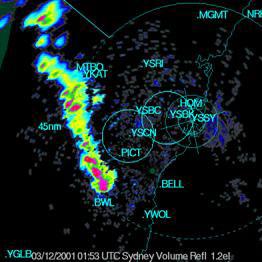
Figure 3: Sydney Radar 1253 |
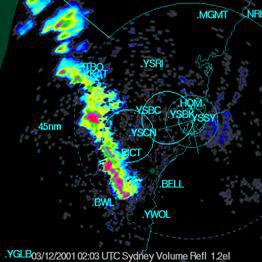
Figure 4: Sydney Radar 1303 |
The BoM reported that individual storm cells in that line had tops of 25,000 to 30,000 ft. Part of the squall line passed over the Sydney radar at 1320 and continued to develop, assisted by the inflow of moist surface air (Figure 5 and 6).
|
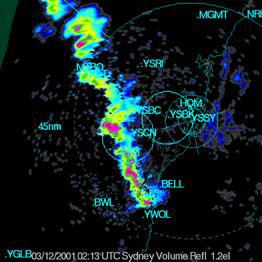
Figure 5: Sydney Radar 1313 |
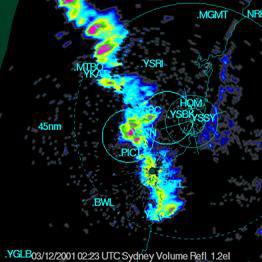
Figure 6: Sydney Radar 1323 |
By 1340, the line of thunderstorms was close to Sydney airport (Figure 7 and 8).

|

|
By 1420 the squall line had cleared Sydney airport.
The BoM Sydney terminal area forecast (TAF) for the 24-hour period commencing at 0500, issued at 0350, included a 30% probability of thunderstorms for that afternoon (the same intermittent weather was included on an amended TAF issued at 0930). The 1300 Trend Type Forecast issued at 1304 amended that forecast to include intermittent periods of thunderstorm activity commencing from 1345.
At 1230, BoM issued an Airport Warning for Sydney advising of expected wind gusts in excess of 41 kts in the following hour. At 1334, BoM issued a lightning alert to airport ground staff warning that lightning had been observed within 10 km of Sydney airport.
At about 1230, the Sydney Traffic Manager (TM) became aware of the approaching thunderstorms. At 1300, the TM called the RAN Fleet Operations Officer to coordinate the early release of the restricted area to facilitate possible aircraft diversions into that area. On previous occasions when aircraft had needed additional airspace to avoid weather the area had been able to be released to Sydney Air Traffic Control at relatively short notice. The area was planned to be active for the afternoon but the Fleet Operations Officer approved the release of the eastern portion of the area from 1430. The TM accepted the partial release of the area from 1430 and warned the operations officer that emergency diversions might still occur before that time. The TM also had controllers notify pilots of departing aircraft of the approaching thunderstorms.
When it was apparent that the aircraft were likely to enter the active restricted area at about 1330, the crews of both aircraft were instructed to activate their aircraft transponders to code 7700 and to broadcast intentions on the Very High Frequency (VHF) emergency frequency 121.5 Mhz. The crews complied with those instructions.
The occurrence highlights the need for collaborative decision making between forecasters, controllers and pilots during periods of thunderstorm activity. It has similarities with a weather-related occurrence in Brisbane during January 2001 that was investigated by the Australian Transport Safety Bureau. That investigation found a number of factors, including factors related to controller and pilot decision making, and the need for increased communication during periods of convective weather. The ATSB made a number of recommendations following that investigation.
For more information see Occurrence report BO/200100213.


